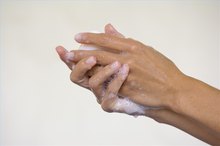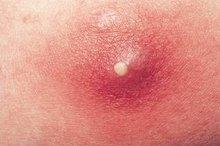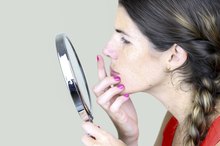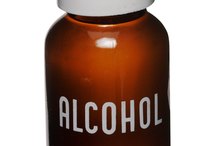What does fact checked mean?
At Healthfully, we strive to deliver objective content that is accurate and up-to-date. Our team periodically reviews articles in order to ensure content quality. The sources cited below consist of evidence from peer-reviewed journals, prominent medical organizations, academic associations, and government data.
The information contained on this site is for informational purposes only, and should not be used as a substitute for the advice of a professional health care provider. Please check with the appropriate physician regarding health questions and concerns. Although we strive to deliver accurate and up-to-date information, no guarantee to that effect is made.
How to Treat Boils With Tea Tree Oil
Boils are localized infections that originate deep under the skin. As the blood cells gather to fight the infection, the boil becomes enlarged, inflamed and tender to the touch. Boils can be caused by bacteria that can find their way under the skin through hair follicles. Boils are often treated with antibiotics, or are lanced and drained in a doctor's office. A method that can be tried at home is treating the boil with tea tree oil 1. A study reviewed in the Letters of Applied Microbiology in 1993 states that tea tree oil kills germs and bacteria that do not respond to antibiotics 1. Tea tree oil's anti-fungal and anti-bacterial properties make it a good home treatment for skin conditions 1.
Wash the boil area with warm water and a mild soap.
How to Treat an Abscess With Home Remedies
Learn More
Place a warm compress on the boil for 5 minutes before applying the tea tree oil 1.
Put enough tea tree oil on a cotton ball to cover the boil 1. Apply the oil directly to the boil, and keep it in place for 3 to 10 minutes. You can apply the cotton ball to the boil, then secure it in place with an adhesive bandage if desired.
How to Treat a Boil Under an Arm
Learn More
Don't rinse the tea tree oil from the skin 1. Remove the cotton ball and rub in any excess oil.
Repeat this process twice a day until the boil comes to a head. When the head of the boil is swollen and white, gently apply pressure to the side of it with a cotton ball soaked in tea tree oil 1. If the boil is ready to drain, it won't take a great deal of pressure to burst. If it doesn't open easily, it's not ready to drain naturally. Keep repeating the tea tree oil treatment until it comes to a head and erupts 1.
Apply tea tree oil to the boil area for up to a week after it has drained to kill any residual bacteria 1.
Tips
Test the tea tree oil on a small patch of your skin to make sure you don't have any reaction to it. If you find it burns, dilute it by mixing 1 part olive oil to 2 parts tea tree oil.
Warnings
If you apply the tea tree oil for 7 to 10 days with no results, consult your physician to see if your boil is so deep that it must be lanced. If you have diabetes, consult your physician before treating any skin sores or wounds at home.
Related Articles
References
- Benefits of Tea Tree Oil
- Mayo Clinic: Boils Causes and Treatment
- Lee C, Chen L, Chen L et al. Correlations of the components of tea tree oil with its antibacterial effects and skin irritation. J Food Drug Anal. 2013;21(2):169-176. doi:10.1016/j.jfda.2013.05.007
- OSHIMS. Ti Tree, Tea Tree.
- National Center for Complementary and Integrative Health. Tea Tree Oil. Updated December 1, 2016.
- Satchell A, Saurajen A, Bell C, Barnetson R. Treatment of interdigital tinea pedis with 25% and 50% tea tree oil solution: A randomized, placebo-controlled, blinded study. Australasian Journal of Dermatology. 2002;43(3):175-178. doi:10.1046/j.1440-0960.2002.00590.x
- Buck DS, Nidorf DM, Addino JG. Comparison of two topical preparations for the treatment of onychomycosis: Melaleuca alternifolia (tea tree) oil and clotrimazole. J Fam Pract. 1994;38(6):601-5.
- Syed T, Qureshi Z, Ali S, Ahmad S, Ahmad S. Treatment of toenail onychomycosis with 2% butenafine and 5% Melaleuca alternifolia (tea tree) oil in cream. Tropical Medicine and International Health. 1999;4(4):284-287. doi:10.1046/j.1365-3156.1999.00396.x
- Buck DS, Nidorf DM, Addino JG. Comparison of Two Topical Preparations for the Treatment of Onychomycosis: Melaleuca Alternifolia (Tea Tree) Oil and Clotrimazole. J Fam Pract. (1994) 38 (6): 601-605.
- Crawford GH, Sciacca JR, James WD. Tea Tree Oil: Cutaneous Effects of the Extracted Oil of Melaleuca Alternifolia. Dermatitis. (2004) 15 (2): 59-66.
- Hammer KA, Carson CF, Riley TV, Nielsen JB. A Review of the Toxicity of Melaleuca Alternifolia (Tea Tree) Oil. Food Chem Toxicol. (2006) 44 (5): 616-625.
- Henley D, Lipson N, Korach K, Bloch C. Prepubertal Gynecomastia Linked to Lavender and Tea Tree Oils. "New England Journal of Medicine", Feb. 1, 2007.
- Morris MC, Donoghue A, Markowitz JA, Osterhoudt KC. Ingestion of Tea Tree Oil (Melaleuca Oil) By a 4-Year-Old Boy. Pediatr Emerg Care. (2003) 19 (3): 169-171.
- Satchell AC, Saurajen A, Bell C, Barnetson RS. Treatment of Interdigital Tinea Pedis With 25% and 50% Tea Tree Oil Solution: A Randomized, Placebo-Controlled, Blinded Study. Australas J Dermatol. (2002) 43 (3): 175-178.
- Satchell AC, Saurajen A, Bell C, Barnetson RS. Treatment of Dandruff With 5% Tea Tree Oil Shampoo. J Am Acad Dermatol. (2002) 47(6) :852-855.
- Syed TA, Qureshi ZA, Ali SM, Ahmad S, Ahmad SA. Treatment of Toenail Onychomycosis With 2% Butenafine and 5% Melaleuca Alternifolia (Tea Tree) Oil in Cream. Trop Med Int Health. (1999) 4 (4): 284-287.
- Bassett IB, Pannowitz DL, Barnetson RS. A Comparative Study of Tea-Tree Oil Versus Benzoylperoxide in the Treatment of Acne. Med J Aust. (1990) 153 (8): 455-458.
Tips
- Test the tea tree oil on a small patch of your skin to make sure you don't have any reaction to it. If you find it burns, dilute it by mixing 1 part olive oil to 2 parts tea tree oil.
Warnings
- If you apply the tea tree oil for 7 to 10 days with no results, consult your physician to see if your boil is so deep that it must be lanced. If you have diabetes, consult your physician before treating any skin sores or wounds at home.
Writer Bio
A certified nutritionist who majored in health, fitness and nutrition, Traci Vandermark has been writing articles in her specialty fields since 1998. Her articles have appeared both online and in print for publications such as Simple Abundance, "Catskill Country Magazine," "Birds and Blooms," "Cappers" and "Country Discoveries."








